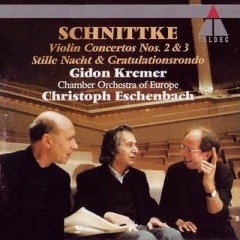Schnittke – Violin Concertos Nos.2 & 3, Stille Nacht
Schnittke – Violin Concertos Nos.2 & 3, Stille Nacht

1. Concerto pour violon no. 2
2. Stille Nacht
3. Gratulationsrondo
4. Concerto pour violon no. 3, 1. Moderato
5. Concerto pour violon no. 3, 2. Agitato
6. Concerto pour violon no. 3, 3. Andante
Gidon Kremer: violin
Chamber Orchestra of Europe
Christoph Eschenbach: conductor/piano
The Violin Concerto No. 2 (1966) was conceived as an account of Christ's passion, but I don't think anyone would guess that from the music without reading the program. Here Schnittke seems to have quieted his individual voice somewhat and tried to adopt the sounds of the Second Viennese School. We hear odd pointilism, Webern-like leaps, and unusual splashes of colour going much further towards the serialist aesthetic than his other atonalist works of the 1960s. But Schnittke's irrepressible playfulness still manifests itself towards the second half with downright weird brass interruptions.
We make a leap of over a decade and enter Schnittke's maturity. While the First was imitation of Shostakovich and the second was standard serialism, the Violin Concerto No. 3 (1978) is Schnittke's very own. The violin opens the first movement with a long solo line full of pathos, before meeting minimal accompaniment by one or two winds. There are no tuttis or explosive moments, and the soloist versus orchestra dynamic is like someone walking through a barren wasteland with a few signs of civilization along the way. The second movement is more dramatic, but while Schnittke's perennial humour shows itself here, it is acerbic in the extreme. The third movement gives the piece's most overt example of Schnittke's "polystylism". It opens with sounds right out of the 19th century Viennese tradition, but surprisingly it's all Schnittke's own, not quotation. The Third may be my favourite of the violin concertos. It's certainly his most subversive of the VC tradition. --- Christopher Culver
So it really seems a fait accompli when Schnittke takes one of the greatest lullabies in history—F.X. Gruber's "Silent Night"—and turns it in a skeletal nightmare. Some apparently value-free liner notes to one recording mention that Schnittke's arrangement effects a "lurking astringency in the harmonies which serves to create a strange, otherworldly atmosphere." But let's face it: it doesn't take much to destroy a placid emblem of sanctity for children everywhere, and if you end a violin-transcription of "Silent Night" with a de-tuning of the instrument's pegs, you're bound to create more than merely an "other-worldly atmosphere." Indeed, it seems that audiences got the message pretty quick, responding with fairly tumultuous protest to the subtle but terribly dark alterations Schnittke made to this classic: now phrases end with caustic major sevenths or seconds, and the piano often accompanies in the wrong the key, or lightly touches only lowest notes to create the palpable effect of a wasteland—"Silent Night" tinkling away on some oblivious music box in a post-nuclear shed. --- All Music Guide
download: uploaded 4shared ziddu depositfiles 26G
Last Updated (Sunday, 30 September 2012 22:48)








